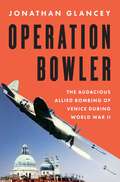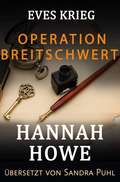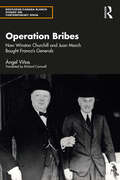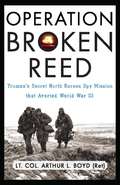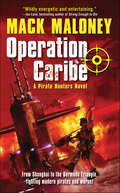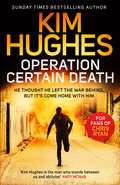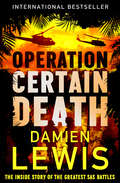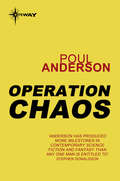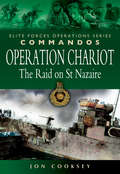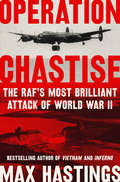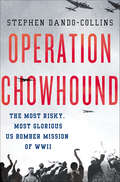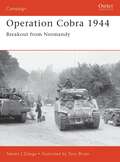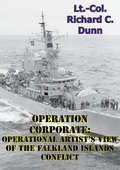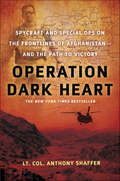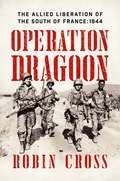- Table View
- List View
Operation Bowler: The Audacious Allied Bombing of Venice during World War II
by Jonathan GlanceyA story of incredible military daring—set against the splendor of Venice—that tells how an unlikely squad of pilots executed the most meticulous air raid of World War II.March 21st, 1945. Bursting through a hazy sky, dozens of Allied fighters and bombers sweep over German-occupied Venice. Their mission: destroy Germany&’s strategic outposts nestled along the port, while leaving the floating city unscathed. As bombs rained down upon Europe, flattening city after city, Venice—La Serenissima; home of Titian and Veronese; immortalized in the serene landscapes of Canaletto—remained sacrosanct. Its artistic and architectural treasure too considerable, too precious to risk destruction. But as the push up through Italy reached its final, grueling months, the Allies were confronted with a terrible dilemma. The ancient city of Venice was now closer and closer to the line of fire. As casualties mounted, the value of art—of history—seemed diminished; just a month earlier Allied bombers had reduced the ancient hilltop abbey of Monte Cassino to a stony husk. In this vivid narrative, bestselling author Jonathan Glancey reveals the thrilling story of Operation Bowler. Following the exploits of audacious Wing Commander George Westlake and his elite team, Operation Bowler explores how an unlikely squad of pilots executed perhaps the most meticulous and complex air raid of World War II, sparing not only Venice but also its people.
Operation Breitschwert (Eves Krieg, Heldinnen der Special Operations Executive #3)
by Hannah HoweOperation Breitschwert ist Buch drei der Reihe Eves Krieg, Heldinnen der Special Operations Executive. Das Buch kann auch als eigenständiges Werk gelesen werden. Aber für das beste Lesevergnügen empfehlen wir, dass Sie die Bücher in der richtigen Reihenfolge lesen. Eves Krieg ist eine Reihe aus zwölf Novellen. Jedes Buch ist circa 20.000 Wörter lang und beinhaltet eine in sich abgeschlossene Geschichte. Der Preis wird für die gesamte Reihe auf ein Minimum gesetzt. Der Handlungsbogen von Eves Geschichte wird am Ende der Reihe beendet. Während Mimi ihr Funkgerät untersuchte, trat eine Gestalt aus der Dunkelheit. Der Mann war Mitte 30, hatte breite Schultern und war muskulös gebaut, während eine stolze Nase und ein sauber gestutzter Schnurrbart seine hübschen Züge dominierten. „Die Eulen sind heute laut“, sagte der Mann in einem tiefen Bariton. „Man kann laut sein, wenn man der weiseste unter den Vögeln ist“, antwortete ich. Als der Code ausgesprochen war, trat der Mann vor und schüttelte meine Hand. Sein Händedruck war fest und die Auf-Ab-Bewegung drohte, meinen Arm auszukugeln. „Ich bin Jean-Claude“, stellte er sich lächelnd vor. „Jean-Claude Quiniou. Ich werde euch zum Unterschlupf führen und euch mit der Le-Roux-Familie bekanntmachen.“ „Ich bin Genevieve“, sagte ich, „und das ist Lise.“ Natürlich verwendete ich unsere Decknamen, denn Eve und Mimi gehörten in ein anderes Leben. Die Bücher in der richtigen Reihenfolge: Operation Zickzack Operation Schlosser Operation Breitschwert Operation Treasure Operation Sherlock Operation Cameo Operation Rose Operation Watchmaker Operation Overlord Operation Jedburgh Operation Butterfly Operation Liberty
Operation Bribes: How Winston Churchill and Juan March Bought Franco’s Generals (Routledge Studies on Contemporary Spain)
by Ángel ViñasThis forensic study of recently opened documents in Britain’s National Archives reveals for the first time the details of an officially unnamed secret operation authorised by Winston Churchill in 1940 to keep Spain neutral in the Second World War through the financial manipulation of Spanish generals.Viñas focuses on the crucial roles played by the British ambassador in Madrid, Sir Samuel Hoare; the embassy’s naval attaché, Captain Alan Hillgarth and – hitherto unknown to Anglophone readers – the Spanish businessman, Juan March, perhaps one of the richest men in Spain at the time and a financial backer of the military conspirators sparking the Spanish Civil War in 1936. He identifies the likely recipients of the bribes, how they were paid and the influence they wielded on Spain’s dictator, General Francisco Franco, who together with his notorious foreign minister, Ramón Serrano Suñer, was minded to enter the war on the side of the Axis. With masterly analysis, this book places the bribes paid by Britain in the jigsaw puzzle of why, after all, Spain remained neutral.This volume is a pioneering and important contribution for scholars and students of Anglo-Spanish relations, Spanish-Axis relations and wider strategic aspects of the Second World War.
Operation Broken Reed: Truman's Secret North Korean Spy Mission that Averted World War III
by Lt. Col. Arthur L. BoydAt the height of the Korean War, President Truman launched one of the most important intelligence - gathering operations in history. <P><P>So valuable were the mission's findings about the North Korean-Soviet-Chinese alliance that it is no stretch to say they prevented World War III. Only one man - sworn to secrecy for a half-century-survived Operation Broken Reed. Arthur Boyd recalls his role as cryptographer on a team of Army Rangers, Navy Frogmen, Air Force officers, and CIA operatives that posed as the captured crew of a B-29 bomber in January 1952. Given cover names and cyanide capsules in case of discovery, the men were transported by Chinese Nationalists wearing Communist uniforms across North Korea, where undercover allies delivered information about troop strengths, weaponry, and intention. Fraught with danger, the mission came apart on its last day when the Americans came under fire from Chinese forces wise to the operation. The members of Broken Reed supplied Truman with proof of massive Chinese and Soviet buildups and a heavy Soviet bomber group in Manchuria, fully loaded with atomic weapons. With the potential destruction of the world outlined in front of him, Truman chose not to escalate the Korean War, saving millions of lives.
Operation C3: Hitler’s Plan to Invade Malta 1942
by John Burtt"Burtt offers an account of how an invasion might have unfolded and its consequences, by drawing on parallel events at other times and places...Definitely worth a read." — The NYMAS ReviewWhen writing his memoirs after World War II, German Generalfeldmarschall Albert Kesselring stated, “Italy’s missing her chance to occupy the island [of Malta] at the start of hostilities will go down in history as a fundamental blunder.” It’s easy to see why this tiny 95 square mile island held such a prominent place in the war’s Mediterranean Theater. Located almost halfway between the British bases of Gibraltar and Alexandria, Egypt, and just 60 miles south of Sicily, her airfields and naval base stood directly in the path of Italy’s (and her German partner’s) line of communication from Europe to North Africa. Operation C3 is a detailed study of the Axis 1942 plan to invade and take the island of Malta. The book examines the future combatants up to the Axis capture of Tobruk, in June 1942. The book then provides a realistic assessment of what would have had to happen if the Axis had decided to launch the invasion. Operation C3 then provides a day-by-day battle narrative of the invasion as if it had occurred on Saturday, August 15, 1942. The battle narrative is based on the combatant’s actual plans from the Italian and Maltese archives. and the realistic appraisal of what could have happened when those plans collide. A Reality & Analysis section is added after the battle narrative to discuss what really happened after Tobruk fell and why Operation C3 was never attempted.
Operation Caribe: A Pirate Hunters Novel (The Pirate Hunters Novels #2)
by Mack MaloneyModern Pirates of the CaribbeanTerror stalks the Bahamas. Someone is killing wealthy seagoing tourists, leaving no clues to the identity of the marauders and no trace of their victims' bodies. The Bahamian police are baffled, and when a Coast Guard boat is discovered on a reef, its officers murdered, tourism authorities realize they need outside help, or this crime wave will ruin the islands' biggest business. Team Whiskey, U.S. soldiers-turned-pirate-hunters, have tangled with Somali pirates, retrieved millions of dollars of stolen cargo and thwarted other high-seas piracy. They run to ground a gang of ruthless Caribbean pirates, but before they can tie up the loose ends, they have unfinished business to settle with Asia's pirate kingpin. When they return, they face a threat more deadly than any piracy, a plot that'll blow the Caribbean sky high, unless the pirate hunters can do what even the U.S. Navy cannot . . .At the Publisher's request, this title is being sold without Digital Rights Management Software (DRM) applied.
Operation Certain Death: A Dom Riley Thriller
by Kim Hughes&‘A powerful tale from an author who knows his stuff. Addictively compelling, you&’ll be reading into the small hours&’ Alan McDermott, author of Fight to SurviveHE THOUGHT HE'D LEFT THE WAY BEHIND. BUT IT'S COME HOME WITH HIM. A bomb explodes in a newly designed shopping complex, ripping through the lives of everyone in its wake. Confirmed as a targeted terrorist attack, special units are quickly brought in to lock down the area. For bomb-disposal expert, Staff Sergeant Dominic Riley, Afghanistan never feels far away and that&’s especially true on the morning of the bombing. And it's only just beginning. The bomb-maker has bigger plans in place, designed for maximum destruction. Plans that are personal to Riley - and his family. And he has no qualms about how many innocent bystanders are caught in the firestorm. But our fate is in the hands of a man who has his own demons to face. And they might just push him over the edge . . .Perfect for fans of Ollie Ollerton, Andy McNab and Mark 'Billy' Billingham, this is the first breathless, edge-of-your-seat thriller from Sunday Times bestselling author and bomb disposal expert, Kim Hughes GC. Praise for Kim's memoir Painting the Sand: 'Breathtaking. Kim Hughes is the man who stands between us and oblivion' Andy McNab (author of Bravo Two Zero) 'An uplifting and enlightening account of the personal courage and dedication required to do a very lonely job in the most extreme of conditions' John Nichol (The Mail On Sunday)
Operation Certain Death: THE INSIDE STORY OF THE SAS’S GREATEST BATTLE
by Damien LewisOperation Certain Death chronicles the story of the single most daring Special Forces operation since World War Two - Operation Barras; the attempted rescue by the SAS of the British Forces who were being held captive by guerrilla gang the West Side Boys in the Sierra Leone jungle. The West Side Boys were a strange-looking bunch, wearing pink shades, shower caps, fluorescent wigs and voodoo charms they believed made them invulnerable to bullets - an impression re-enforced by ganja, heroine, crack cocaine and gallons of sweet palm wine. In 1999 a twelve man patrol of Royal Irish Rangers, who were training government troops in Sierra Leone, were captured and held hostage by the West Side Boys. They were held prisoner in a fortified jungle hideaway, with severed heads decorating the palisades, defended by some 400 heavily armed soldiers.Operation Barras, the rescue mission, was a combined force of 100 Paras, twelve members of the Special Boat Squadron, helicopters from the Navy and RAF and, spearheading the operation, 40-strong D squadron of the SAS. Against amazing odds the hostages were rescued - over 150 of the enemy were killed. Operation Certain Death is a thrilling true story of all out war. No hostages taken. Blood-letting on a vast scale inflicted on a very blood-thirsty enemy. A gripping piece of true military history, perfect for fans of action adventure stories and anyone interested in the top secret division of the British Army.'As good as any thriller I have ever read' Frederick Forsyth(P)2023 Quercus Editions Limited
Operation Certain Death: The Inside Story of the Greatest SAS Battles
by Damien LewisThe terrifyingly true tale of a daring British special forces rescue mission and all-out assault on a savage Sierra Leone guerrilla gang: &“What a story!&” (Frederick Forsyth, #1 New York Times–bestselling author of The Day of the Jackal). Officially, the SAS mission was called Operation Barras. The men on the ground called it Operation Certain Death. In 2000, the British Special Air Service (SAS) attempted its riskiest rescue mission in more than half a century. A year before, an eleven-man patrol of Royal Irish Rangers who were training government troops in Sierra Leone was captured and held prisoner by the infamously ruthless rebel forces known as the West Side Boys. Their fortified base was hidden deep in the West African jungle, its barricades adorned with severed heads on spikes. Some four hundred heavily armed renegades were not only bloodthirsty—they were drink-and-drugs crazed. The guerrillas favored pink shades, shower caps, and fluorescent wigs, draping themselves in voodoo charms they believed made them bulletproof—a delusion reenforced by the steady consumption of ganja, heroin, crack, and sweet palm wine. This was the vicious and cutthroat enemy British special forces would confront in order to rescue their own. Featuring extensive interviews with survivors, this gritty, blow-by-blow account of the bloody battle that brought an end to ten years of Africa&’s most brutal civil war is &“as good as any thriller I have ever read. This really is the low down&” (Frederick Forsyth).
Operation Chaos
by Poul AndersonSteve Matuckek Book 1In a war waged against Black Magic, the fact that Steve is a werewolf and his wife is a highly skilled witch is not unusual. But their adventures prove very unusual, even for their world, when they are given the task of neutralizing an enemy's ultimate weapon - the world's most powerful demon.
Operation Chaos: The Vietnam Deserters Who Fought the CIA, the Brainwashers, and Themselves
by Matthew SweetAn untold Cold War story: how the CIA tried to infiltrate a radical group of U.S. military deserters, a tale that leads from a bizarre political cult to the heart of the Washington establishmentStockholm, 1968. A thousand American deserters and draft-resisters are arriving to escape the war in Vietnam. They’re young, they’re radical, and they want to start a revolution. Some of them even want to take the fight to America. The Swedes treat them like pop stars—but the CIA is determined to stop all that.It’s a job for the deep-cover men of Operation Chaos and their allies—agents who know how to infiltrate organizations and destroy them from inside. Within months, the GIs have turned their fire on one another. Then the interrogations begin—to discover who among them has been brainwashed, Manchurian Candidate-style, to assassinate their leaders.When Matthew Sweet began investigating this story, he thought the madness was over. He was wrong. Instead, he became the confidant of an eccentric and traumatized group of survivors—each with his own theory about the traitors in their midst. All Sweet has to do is find out the truth. And stay sane. Which may be difficult when one of his interviewees accuses him of being a CIA agent and another suspects that he’s part of a secret plot by the British royal family to start World War III. By that time, he’s deep in the labyrinth of truths and half-truths, wondering where reality ends and delusion begins.
Operation Chariot: The Raid on St Nazaire (Elite Forces Operations Series)
by Jon CookseyBy March 1942, mainland France had been under German occupation for almost two years. Every month that passed saw Germany bolster her defenses against an expected allied invasion. Every month that passed saw Germany tighten her grip on Britain's transatlantic lifeline; menacing allied shipping from the French west coast ports. At St Nazaire on the Loire estuary, the vast Normandie dry dock was the only one capable of holding the mighty battleship Tirpitz, still at large and free to hunt allied ships. Something had to be done. Operation Chariot was conceived; an audacious plan to mount a large-scale commando raid on the Normandie dock using a loaned US destroyer packed with high explosive as a battering ram. For the Germans at St Nazaire the invasion came earlier than expected. In the dead of night British commandos were landed and swarmed over the quaysides to destroy key installations. Grit, determination and training carried them forward to accomplish their mission at a heavy price in dead, wounded and captured. The award of more than eighty decorations for the raid - including five VCs - bore witness to the ferocity of the struggle to strike at the Germans in France.
Operation Chariot: The St Nazaire Raid, 1942 (Casemate Illustrated #Cis0013)
by Jean-Charles StasiAn illustrated history of the World War II British amphibious attack on a dry dock in the German-occupied French town. At the beginning of 1942, the prospect of Germany&’s Tirpitz, the heaviest battleship ever built by a European navy, patrolling the Atlantic posed a huge threat to the convoys that were the lifeline for Britain. Bombing raids to destroy the ship failed. A more radical plan was conceived to destroy the dry-dock facility at St Nazaire on the French Atlantic coast. Without the use of the only suitable base for the ship, the threat would be neutralized. The plan was to ram the entrance gates with a ship packed with explosives on a delayed fuse. A motorboat armed with torpedoes would fire at the inner gate causing further damage to submarine pens. The troops and crew would then destroy as many dockyard targets as they could and withdraw in fast motor launches that had followed them in. All this was to be achieved under cover of an air raid. HMS Campbeltown, a U.S. lend-lease destroyer, was chosen for the task. On the night of March 27, the raid commenced. The Campbeltown succeeded in lodging its bows in the outer gates. The fuses detonated the explosives in its hold the following day. The dock gates were destroyed. The cost to the Allies was high, but the Tirpitz was never able to leave Norwegian waters. This volume in the Casemate Illustrated series gives a clear overview of the planning and execution of the raid and its aftermath, accompanied by 125 photographs and images, including color profiles and maps.
Operation Chastise: The RAF's Most Brilliant Attack of World War II
by Max HastingsOne of the most lauded historians of our time returns to the Second World War in this magnificent retelling of the awe-inspiring raid on German dams conducted by the Royal Army Force’s 617 Squadron.The attack on Nazi Germany’s dams on May 17, 1943, was one of the most remarkable feats in military history. The absurdly young men of the Royal Air Force’s 617 Squadron set forth in cold blood and darkness, without benefit of electronic aids, to fly lumbering heavy bombers straight and level towards a target at a height above the water less than the length of a bowling alley. Yet this story—and the later wartime experience of the 617 Squadron—has never been told in full. Max Hastings takes us back to the May 1943 raid to reveal how the truth of that night is considerably different from the popularized account most people know. The RAF had identified the Ruhr dams as strategic objectives as far back as 1938; in those five years Wing Commander Guy Gibson formed and trained the 617 Squadron. Hastings observes that while the dropping of Wallis’s mines provided the dramatic climax, only two of the eight aircraft lost came down over the dams—the rest were shot down on the flight to, or back from, the mission. And while the 617 Squadron’s valor is indisputable, the ultimate industrial damage caused by the dam raid was actually rather modest. In 1943, these brave men caught the imagination of the world and uplifted the weary spirits of the British people. Their achievement unnerved the Nazi high command, and caused them to expend large resources on dam defenses—making the mission a success. An example of Churchill’s “military theatre” at its best, what 617 Squadron did was an extraordinary and heroic achievement, and a triumph of British ingenuity and technology—a story to be told for generations to come.Operation Chastise includes three 8-page black-and-white photo inserts and 6 maps.
Operation Chowhound: The Most Risky, Most Glorious US Bomber Mission of WWII
by Stephen Dando-CollinsThe true story of a little-known, yet remarkable World War II operation, which had all the hallmarks of a suicide mission.Beginning with a crazy plan hatched by a suspect prince, and an even crazier reliance on the word of the Nazis, Operation Chowhound was devised. Between May 1 and May 8, 1945, 2,268 military units flown by the USAAF, dropped food to 3.5 million starving Dutch civilians in German-occupied Holland. It took raw courage to fly on Operation Chowhound, as American aircrews never knew when the German AAA might open fire on them or if Luftwaffe fighters might jump them. Flying at 400 feet, barely above the tree tops, with guns pointed directly at them, they would have no chance to bail out if their B-17s were hit—and yet, over eight days, 120,000 German troops kept their word, and never fired on the American bombers. As they flew, grateful Dutch civilians spelled out "Thanks Boys" in the tulip fields below. Many Americans who flew in Operation Chowhound would claim it was the best thing they did in the war. In this gripping narrative, author Stephen Dando-Collins takes the reader into the rooms where Operation Chowhound was born, into the aircraft flying the mission, and onto the ground in the Netherlands with the civilians who so desperately needed help. James Bond creator Ian Fleming, Hollywood actress Audrey Hepburn, as well as Roosevelt, Eisenhower, and Churchill all play a part in this story, creating a compelling, narrative read.
Operation Cobra 1944
by Steven Zaloga Tony BryanOne of the most decisive months of World War II (1939-1945) was the 30 days between 25 July and 25 August 1944. After the success of the D-Day landings, the Allied forces found themselves bogged down in a bloody stalemate in Normandy. On 25 July General Bradley launched Operation Cobra to break the deadlock. US forces punched a hole in the German frontline and began a spectacular advance. As Patton's Third Army poured into Brittany and raced south to the Loire, the German army was threatened with encirclement. By the end of August German forces in Normandy were utterly destroyed, and the remaining German units in central and southern France were in headlong retreat to the German frontier. In this title Steve Zaloga explains how the breakout from Normandy came about.
Operation Cobra and the Great Offensive
by Bill YenneTHE BEGINNINGS OF VICTORYShortly after the D-Day invasion, the Allied forces in Europe had stalled. A limited operation was set in motion to punch a small hole in the enemy defenses, starting on July 25, 1944. It was called Operation Cobra, and it would become one of the greatest offensives in all of military history. In the sixty days following the launch of the operation, the Allies -- commanded by Dwight Eisenhower and led by men such as the irascible General George Patton and General Omar Bradley -...
Operation Compass 1940
by Jon Latimer Jim LaurierOsprey's Campaign title for the first battle of the desert war, Operation Compass, which was originally envisaged as a spoiling attack, combined with a reconnaissance in force to disrupt the Italian forces that had advanced into Egypt in September 1940. Lt Gen. Richard O'Connor launched what amounted to a British 'Blitzkrieg'. In less than two months the British forces swept 500 miles along the coast of North Africa. 7th Armoured Division raced across the desert to cut off the retreating Italians, and O'Connor's men destroyed 9 Italian divisions, and took 130,000 prisoners. In March 1941 General Rommel and the Afrikakorps landed at Tripoli.
Operation Corporate: Operational Artist's View Of The Falkland Islands Conflict
by Lieutenant Colonel Richard C. Dunn USMCOn 2 April 1982, after more than 16 years of inconclusive diplomatic negotiations with Great Britain, Argentina launched Operativo ROSARIO, a military campaign designed to take by military means what the Argentine government could not secure by political means: the Islas Malvinas or what the British and the Islanders call the Falklands. As happens in many such instances, the Argentine government miscalculated the political resolve and military response of their British opponent. Refusing to accept the Argentine military action as a “fait accompli”, the British government responded to the Argentine invasion of the Falkland Islands with Operation CORPORATE, a military campaign to regain her lost territory. Great Britain, a major world political power and NATO member, and Argentina, a 3rd world nation with major power aspirations, resorted to military force to resolve their political differences over the future of a small cluster of mostly uninhabited islands in the South Atlantic. Thus began the Falkland Islands conflict.This paper will analyze the Falkland Islands conflict from the viewpoint of an operational commander. To facilitate this process, three general areas will be reviewed: (1) political considerations, (2) strategic objectives, and (3) operational factors, including objectives, centers of gravity (COGs) and employment of forces. Based on my conclusions, specific recommendations will be offered which directly impact on the operational level of war for the U.S. commander.
Operation Crossbow: The Untold Story of the Search for Hitler’s Secret Weapons
by Allan WilliamsThe story of the photographic intelligence work undertaken from a country house at Medmenham, Buckinghamshire, is one of the great lost stories of the Second World War . At its peak in 1944, almost 2,000 British and American men and women worked at the top-secret Danesfield House, interpreting photographs - the majority stereoscopic so they could be viewed in 3D - to unlock secrets of German military activity and weapons development. Millions of aerial photographs were taken by Allied pilots, flying unarmed modified Spitfires and Mosquitos on missions over Nazi Europe. it was said that an aircraft could land, the photographs be developed and initial interpretation completed within two hours - marking the culmination of years of experiments in aerial intelligence techniques.Their finest hour began in 1943, during the planning stages of the Allied invasion of Europe, when Douglas Kendall, who masterminded the interpretation work at Medmenham, led the hunt for Hitler's secret weapons. Operation Crossbow would grow from a handful of photographic interpreters to the creation of a hand-picked team, and came to involve interpreters from across the Medmenham spectrum, including the team of aircraft specialists led by the redoubtable Constance Babington Smith. In November that year, whilst analysing photographs of Peenemunde in northern Germany, they spotted a small stunted aircraft on a ramp. This intelligence breakthrough linked the Nazi research station with a growing network of sites in northern France, where ramps were being constructed aligned not only with London, but targets throughout southern Britain.Through the combined skill and dedication of the Crossbow team and the heroism of the Allied pilots, throughout late 1943 and 1944 V-weapon launch sites were located and through countermeasures destroyed, saving hundreds of thousands of lives, and changing the course of the war.Operation Crossbow is a wonderful story of human endeavour and derring-do, told for the first time.
Operation Crusader: Tank Warfare in the Desert, Tobruk 1941 (Die Wehrmacht im Kampf)
by Hermann BuschlebA 1960s German perspective of the World War II battle in Libya and how the Allied and Axis commanders shaped the course of the action. The port city of Tobruk, Libya, was besieged by German and Italian forces in April, 1941. Following an abortive attempt in June, the Allies made a second attempt in late November, when the Eighth Army launched Operation Crusader, aimed at destroying the Axis armored force then advancing. After several inconclusive engagements, the British 7th Armoured Division was defeated by the Afrika Korps at Sidi Rezegh. Erwin Rommel was then forced to withdraw his troops to the defensive line at Gazala, making the operation the first Allied victory over German land forces in World War II. This account of the tank warfare during Operation Crusader in front of Tobruk in the fall of 1941 examines the roles of commanders in the battles of Operation Crusader, in particular the part of Rommel, who achieved some defensive successes during combat. As well as examining the part of commanders, it discusses the parameters of the battle: the terrain, weather, visibility, logistics, intelligence, and the forces involved. It then narrates the course of the battle, and the result.
Operation Dark Heart: Spycraft and Special Ops on the Frontlines of Afghanistan -- and the Path to Victory
by Anthony ShafferOn Friday, August 13, 2010, just as St. Martin's Press was readying its initial shipment of this book, the Department of Defense contacted us to express its concern that our publication of Operation Dark Heart could cause damage to U.S. national security. After consulting with our author, we agreed to incorporate some of the government's changes into a revised edition of his book while redacting other text he was told was classified. The newly revised book keeps our national interests secure, but this highly qualified warrior's story is still intact; Shaffer's assessment of successes and failures in Afghanistan remains dramatic, shocking, and crucial reading for anyone concerned about the outcome of the war. While I do not agree with the edits in many ways, the DoD redactions enhance; the reader's understanding by drawing attention to; the flawed results created by a disorganized and heavy handed military intelligence bureaucracy. Lt. Col. Anthony Shaffer had run intelligence operations for years before he arrived in Afghanistan. He was part of the; dark side of the force;---the shadowy elements of the U.S. government that function outside the bounds of the normal system. His group called themselves the Jedi Knights and pledged to use the dark arts of espionage to protect the country from its enemies. Shaffer's mission to Afghanistan, however, was unlike any he had ever experienced before. There, he led a black-ops team on the forefront of the military efforts to block the Taliban's resurgence. They not only planned complex intelligence operations to beat back the insurgents, but also played a key role in executing those operations---outside the wire. They succeeded in striking at the core of the Taliban and their safe havens across the border in Pakistan. For a moment Shaffer saw us winning the war. Then the military brass got involved. The policies that top officials relied on were hopelessly flawed. Shaffer and his team were forced to sit and watch as the insurgency grew---just across the border in Pakistan. This wasn't the first time he had seen bureaucracy stand in the way of national security. He had participated in Able Danger, the aborted intelligence operation that identified many of the future 9/11 terrorists but failed to pursue them. His attempt to reveal the truth to the 9/11 Commission would not go over well with his higher-ups. Operation Dark Heart tells the story of what really went on--and what went wrong--in Afghanistan. Shaffer witnessed firsthand the tipping point, when what seemed like certain victory turned into failure. Now, in this book, he maps out a way that could put us on the path to winning the war.
Operation Dark Heart: Spycraft and Special Ops on the Frontlines of Afghanistan—and the Path to Victory
by Anthony ShafferOperation Dark Heart tells the story of what really went on—and what went wrong—in Afghanistan. Lt. Col. Anthony Shaffer led a black-ops team on the forefront of the military efforts to block the Taliban's resurgence.For a moment he saw us winning the war. Then the military brass got involved. He witnessed firsthand the tipping point, when what seemed like certain victory turned into failure.This wasn't the first time he had seen bureaucracy stand in the way of national security. He had participated in Able Danger, the aborted intelligence operation that identified many of the future 9/11 terrorists but failed to pursue them. His attempt to reveal the truth to the 9/11 Commission would not go over well with the higher-ups.Operation Dark Heart made headlines when the Department of Defense bought the entire unredacted first printing. The book's revised second printing includes redactions, which, according to The New York Times, "offer a rare glimpse behind the bureaucratic veil that clocks information the government considers too important for public airing." But most importantly, Operation Dark Heart remains a stirring indictment against military bureaucracy and a culture of cover-ups.
Operation Dragoon 1944: France's Other D-Day
by Steven Zaloga John WhiteOsprey's study of Operation Dragoon, the Allied landings in southern France on August 15, 1944, which was one of the most controversial operations of World War II (1939-1945), leading to deep divides between United States and British planners. The US objective was to threaten the rear of the German armies occupying France by a landing on the eastern French coast and to push rapidly northward towards Lorraine to meet up with Allied forces bursting out of Normandy. Dragoon was a complex operation very similar to the Normandy landings, complete with a US and British airborne assault followed by a naval assault landing. The landings led to a precipitous German retreat from France, authorized by Hitler himself. In September 1944, the US Seventh Army and French First Army reached Lorraine, sealing off any remaining German troops and completing the liberation of the majority of French territory.Popular Osprey author Steve Zaloga tells the story of this operation, from the derisive debates between the Allied commanders to the men who hit the beaches and charged ashore to help liberate occupied France.
Operation Dragoon: Operation Dragoon And Liberation Of The South Of France
by Robin CrossA dramatic and expertly rendered narrative of the Allied liberation of the South of France during Operation Dragoon in 1944. Operation Dragoon is the story of the Allied invasion of the South of France on August 15, 1944. It was, in effect, the second D-Day, launched two months after “Overlord,” the Allied invasion of Normandy. As such, it has often been overshadowed by its predecessor, but it significance cannot be underestimated. “Dragoon” was a largely American-French operation in which the British, who had argued for action in northern Italy, played a smaller role. After nearly five years of conflict, British war stamina had been severely sapped. In contrast, the French, who had been excluded from the overall planning of D-Day, played an important role in Dragoon, supplying the majority of the ground troops in a campaign which began on the beaches of the Riviera and ended in the cool, clear air of the Alpes Maritimes, the sacred ground of France. Operation Dragoon provides for the first time a complete overview of the liberation of the South of France—from strategic decisions made from the Allied and German high commands to the intelligence war waged by Allied code-breakers; from the German defeat of French resistance forces on the Vergers to the exploits of individual OSS agents on the ground as they strove to keep pace with a fast-moving battlefield. This is the story of the Allies inflicting on the Germany Army a Blitzkrieg-style defeat, expunging the lingering memories of the catastrophe of 1940.
